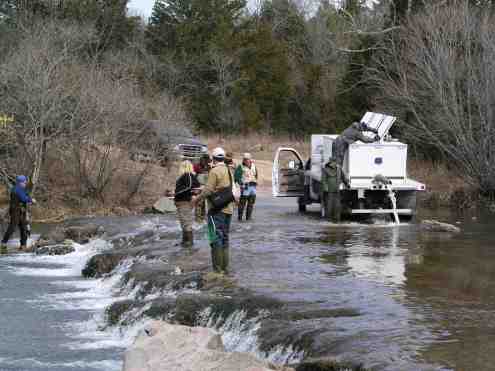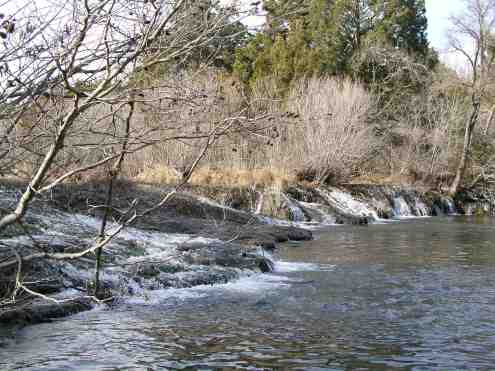“The Blue River is just kind of like a misplaced river,” says Paul Mauck, the South Central Region Fisheries Supervisor for the Oklahoma Department of Wildlife Conservation (ODWC). “It’s got waterfalls, riffles, pools. It has about everything in one package in a six-mile stretch of stream. All the granite outcroppings of the Arbuckle uplift brings all that water right to the surface. It’s exciting!”
Most of the water in the Blue River springs from the Arbuckle-Simpson Aquifer, the giant underground water source so important to this area of the state.
ODWC purchased 900 acres around the river in 1967 to provide public access to what Mauck calls, “ The jewel of southern Oklahoma.” Today, the Blue River Wildlife Management Area has slightly more than six miles of the river and approximately 3,300 acres of land.
Near the entrance to the WMA, Lavada Crawford of Del City sits on a rock, waterfalls behind her, and catches her first rainbow trout from the Blue River. She is one of the approximately 100,000 visitors who come here annually to fish, camp, hike or just relax. It is her first trip to the area and she describes it in a single word, “Beautiful.”
Trout have been stocked here almost from the start, and while the river has a number of native species of game fish, like bass, sunfish and catfish, the trout have proven the most popular. Regular stockings occur from November through March. Trout can still be caught in the river through April. Trout Derbies are held on the river in November, around Veteran’s Day, and in February, close to Valentine’s Day.

Along the low water crossing, anglers line up to fish the riffles. They include serious fly fishermen and those who take the less complicated route, with salmon eggs and Power Bait on spinning rigs. The one thing they all have in common is that they all will catch trout if they try hard enough. There are plenty to go around.
While many anglers gather at the convenient spots around the campgrounds, the Blue River provides opportunities to get away from the crowds. Two walk-in areas, one on the main part of the Wildlife Management Area and the other on the north end near SH-7, take you into areas where most visitors do not venture. You don’t have to fish to enjoy it.
The one-mile walk, in the main area, takes you past Desperado Springs, where clear cold water bubbles from the ground to join the river. Along the way, you will see the river split, tumble through narrows in the woods, and rejoin to form a wider stream before seeking other paths further downstream. You will have most of the walk to yourself. You can marvel at granite boulders bigger than your family car. Songbirds add their voices to the river chorus in a glorious natural concert. At the end of the walk, you find yourself standing beside a wide horseshoe falls that makes the walk worthwhile.
Paul Mauck says it is like therapy. “By having walk in areas like we do, you can get off by yourself and really enjoy some quality time right on the river.”
The two-mile walk, while twice as far, offers twice the experience. At the end of the trail, another waterfall, but this one is six to eight feet high and cascades to a sparkling pool where Mauck says an angler who does not mind the hike can catch a limit of smallmouth bass in the spring.

While you are walking either route, you will see wildlife, perhaps deer or wild turkey, and you will see trees you can see few other places. If you think cedar trees are small and stubby like Christmas trees, the cedars that grow along the banks of the Blue River will surprise you. They are old and tall, almost like the pine trees in southeastern Oklahoma. Later in March, you will see Oklahoma’s traditional spring colors, the dusky darker-than-pink red buds and the almost pure white of the dogwoods. You will also see seaside alders, smooth barked trees common on the east coast that seem almost as misplaced as the river for this part of America.
Camping is popular along the river. There are 100 campsites; none have utilities such as electricity or running water. There is no charge for camping if visitors possess a current Oklahoma hunting or fishing license. Otherwise, campers must purchase a $21 conservation passport to use the property.
While the Blue River becomes more popular each year, Paul Mauck believes it has yet to reach its potential. He says, “Hopefully someday we can make an outdoor classroom for our kids, with interpretive trails. We can teach them the dynamics of the river and how all of this works together, the foliage, the trees, the rocks and the river itself.”
Down here, nature’s complicated formula has come together very well indeed.